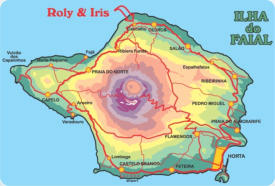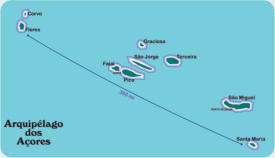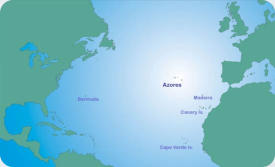

Horta, Faial
The
The Azores, and especially Faial



The Atlantic
The Azores
Faial
The nine islands of the Azores are divided into three groups. The western group of Flores and
Corvo are separated by 120 miles from the five central islands which in turn are 80 miles from
the eastern group of São Miguel and Santa Maria. All the islands are steep-to and most of the
harbours were, until recently, nothing more than a stone jetty for loading ships in a rocky bay.
São Miguel is the largest and most populous island and the capital, Ponta Delgada is located
there. The other island of the Eastern Group is little Santa Maria, once the location of a big
war-time USAF base, it still has a major North Atlantic Air Traffic Control Centre, beautiful
beaches and a big summer music festival. The five islands of the Central Group are, from east
to west, Terceira, so named because it was the third of the islands to be discovered and home
of an American air force base at Lajes; São Jorge surrounded by high cliffs and sparsely
populated, great hiking country; Graciosa, a small agricultural island; Pico, the second-largest
island dominated by the volcano of the same name, the highest point in Portugal at 2,351
metres (7,713 feet) and finally our own island, Faial, of which more in the next paragraph. The
Western Group consists of Flores and Corvo, the most isolated of the Azores. Flores has
spectacular scenery and Corvo is the tiniest of the islands with a permanent population of less
than 400
In spite of being part of the same group, each island has its own very definite character and
our island, Faial, is no exception. The oh-so-green terraced fields rise most of the way up to the
3,000 ft crater in the center. In a group with few natural harbours Faial had the best of a bad lot
in Porto Pim at the south end of Horta. In the 19th century American whaling ships stopped
here in large numbers on their way to the southern whaling grounds and took on many skilled
Azorean seamen as crew. The new harbour wall was built in the 1880's enclosing part of the
bay to the east of Horta making it into a proper commercial port. Cable companies established
relay stations here and built big mansions for the managers; the relay stations went with the
coming of satellites, but the mansions remain. Yachtsmen have stopped in the harbour for over
100 years and for more than 75 of them they have been welcomed by three generations of the
Azevedo family at the Café Sport. From a couple of yachts per year in the 20's and 30's more
than 1,000 now stop at the 20 year old Horta Marina each year. Horta has been a coaling port
too, and a refueling stop for transatlantic fliers including the Pan-Am Clippers of the late 30's.
All these visitors make Faial the most cosmopolitan island in the group; the people are well
used to, and welcome, foreigners.
We live in Cascalho near the northern tip of the island just down the road from the Dairy Co-
op that processes all the milk produced on the island. They make UHT long-life milk, cheese
and butter. The tourist business is slowly increasing with many guest houses opening up on the
island. We don't have miles of golden beaches but we have whale-watching, diving, fishing,
hiking and as much tranquility as you´ll find anywhere in the world today. Just what the doctor
ordered!
A Number of celebrated visitors have written about
the Azores, and particularly Horta over the years
John White in 1590. John White, an English sailor, wrote about a stop in the Azores on the return from a voyage carrying settlers to Virginia Mark Twain in 1860. Mark Twain, the American humorist, made a stop in Faial on his way to Europe. He wrote about the experience in The Innocents Abroad. Joshua Slocum in 1895. Joshua Slocum, an out-of-work Yankee square-rig skipper, rebuilt an old fishing boat into the 35 foot yacht Spray and aboard her he entered the history books as the first man to sail around the world single-handed. He stopped here near the beginning of his voyage. Conor O’Brien in 1925. Conor O’brien left Dublin in 1923 flying the flag of the newly-created Irish Free State to sail around the world the hard way, east-about, in the 42 foot yacht Saiorse. He stopped in Faial on the final leg of his voyage. Eric Hiscock in 1966. For four decades Eric and Susan Hiscock cruised the world’s oceans aboard a succession of yachts named Wanderer. The books they wrote about their travels inspired a generation of small boat sailors.

An Azores Photo Album

click for
An
Azores
Photo Album